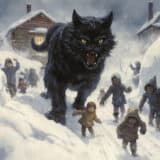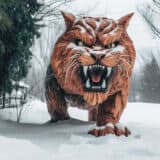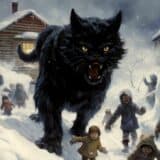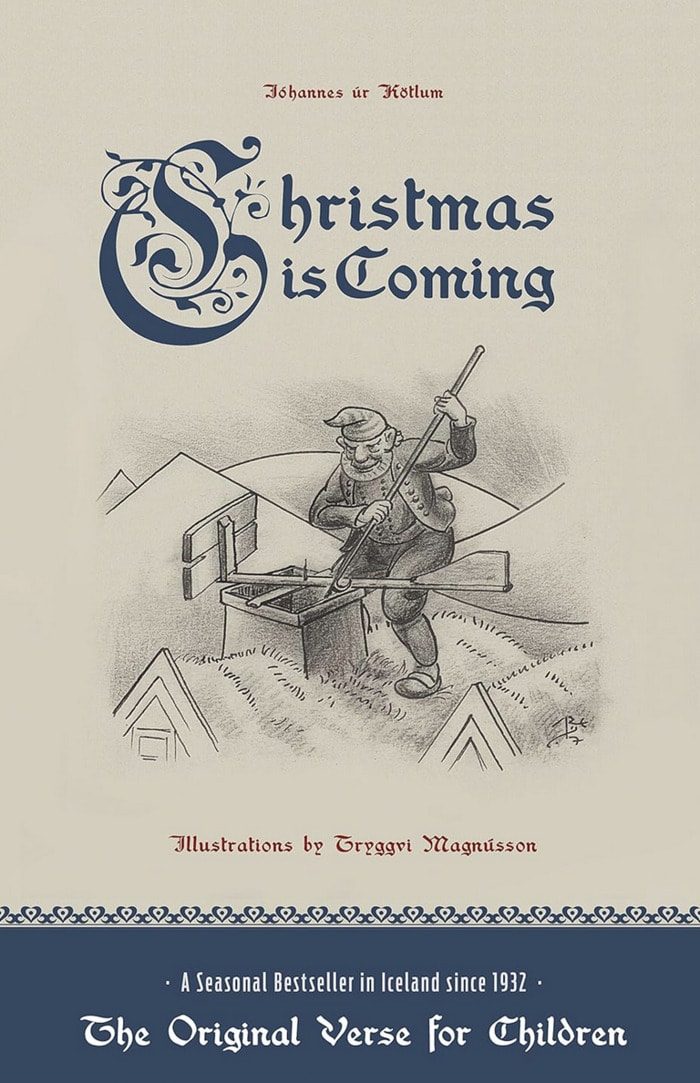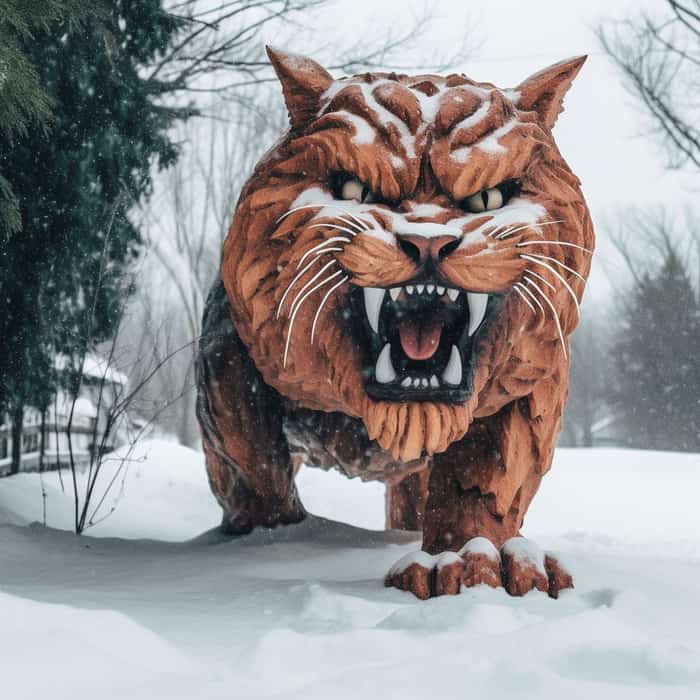The Myth of the Yule Cat: Iceland’s Weird Christmas Monster
Europe has its fair share of unique holiday traditions, and this curious creature is no exception.
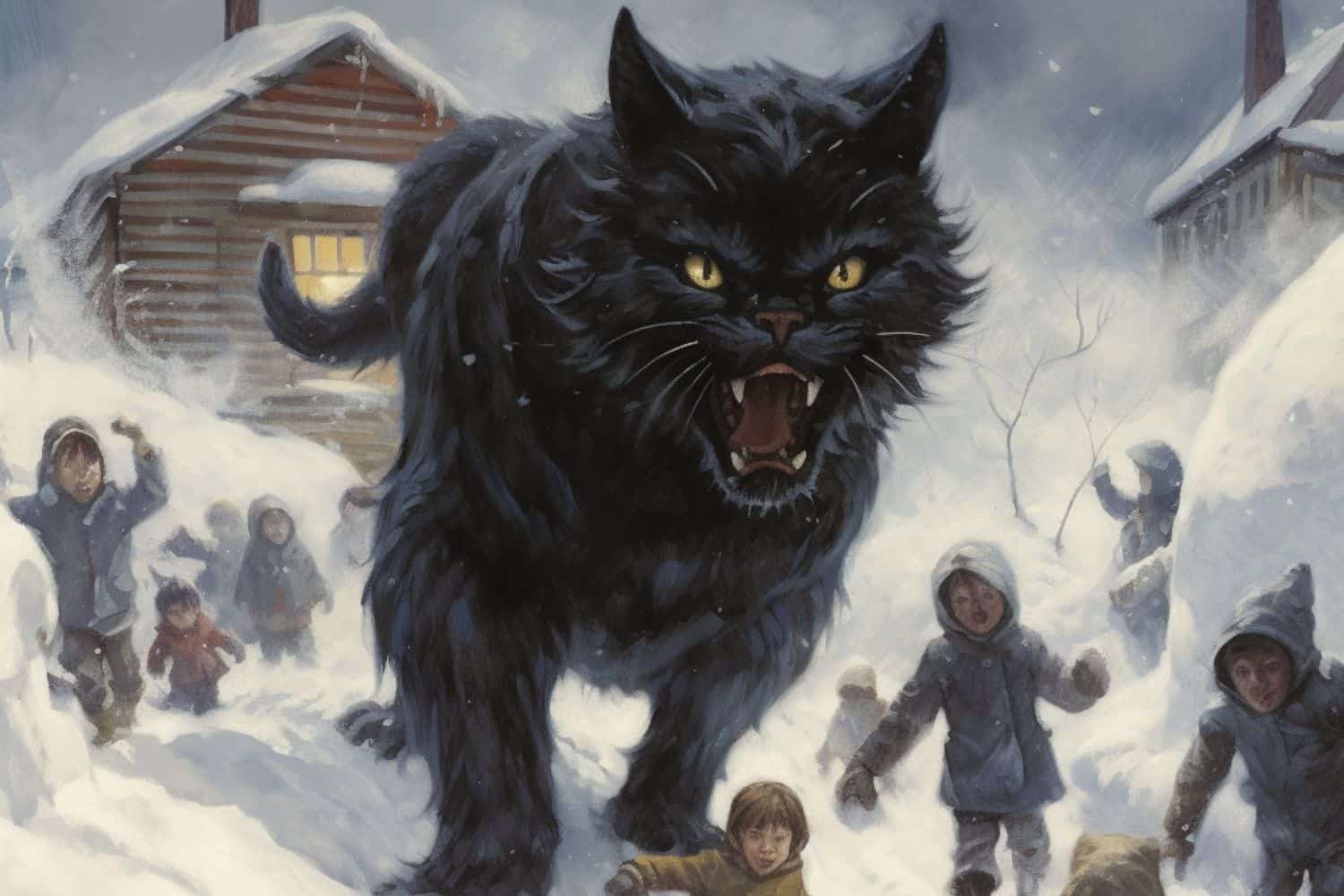
As an Amazon Associate we earn from qualifying purchases. This post may contain affiliate links from Amazon and other sites that we collect a share of sales from. You may learn more here.
The Yule Cat makes its rounds across Iceland each year on Christmas Eve, stalking through snowy winter streets, towering above houses and peering into frosty windows. It searches out those without new socks or scarves amongst their Christmas gifts, and then, as punishment, devours them whole.
This freaky piece of folklore once served as a warning to those who would shirk their duties and leave more work for others over the holidays. Keep reading to discover more about the Yule Cat and its origins.
What Is the Yule Cat?
The Yule Cat, known as Jólakötturinn (YOH-la-ko-tuhrin) in Icelandic, is a massive, formidable creature from Icelandic folklore that prowls the country on Christmas Eve. This giant feline is described as having bright, glowing eyes, needle-like hair, bristle-like whiskers, and a shaggy coat. On top of that, the Yule Cat is said to tower over even the tallest buildings in town as it stalks its prey each holiday season.
According to legend, it towers over the tallest buildings in town during its holiday hunt. Granted, the tallest building in the country is just 256 feet, but still.
Each Christmas, the Jólaköttur makes its rounds, peering through windows and targeting those who haven’t received new clothes for Christmas. Much like Krampus, the Yule Cat’s purpose is to encourage good behavior. Though, these days it seems capitalistic and classist, the myth likely developed as a story to motivate medieval Icelandic farmers into processing their wool stores into yarn before the winter season.
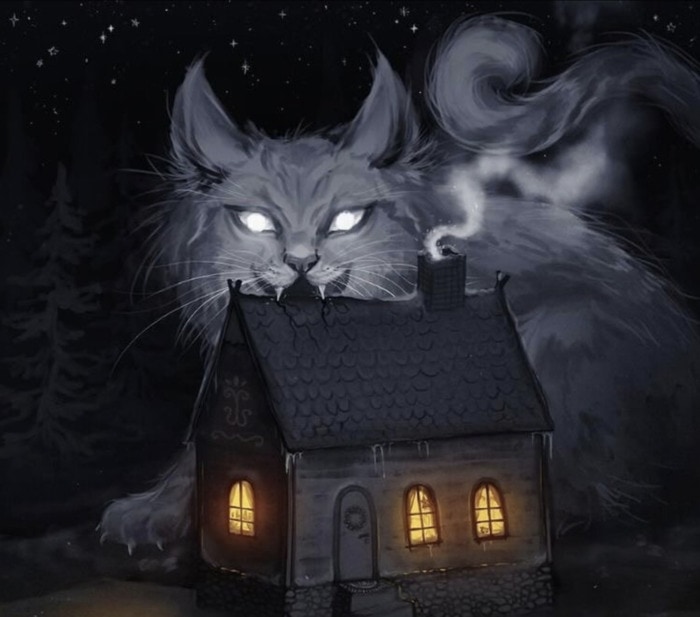
But the Yule Cat isn’t alone on its holiday patrols. The Jólaköttur is a pet of the Icelandic troll ogress Grýla (GREE-la). She is also the mother of the mischievous and unruly Yule Lads, 13 trolls who play pranks on naughty children and reward the well-behaved with presents.
Unlike her sons, Grýla and the Yule Cat don’t offer rewards. The pair stalk the city streets side by side to sate their hunger. While Jólaköttur is fashion-focused, his mistress looks for naughty children to devour, like some kind of macabre Mrs. Claus.
What Are the Yule Cat’s Origins?
The exact origins of the Yule Cat are a bit of a mystery. While it’s accepted the story could have originated during the Dark Ages, the Jólaköttur we’re familiar with today was first popularized in a 20th century poem by Jóhannes úr Kötlum. His poem “The Christmas Cat,” appeared in his 1932 collection of holiday poems, Jólin Koma, which translates to “Christmas is Coming.”
Although the ogress Grýla and her sons the Yule Lads featured in other poems in Jóhannes’ collection, they weren’t originally connected. However, over the years appearing in the same collection of poems created a strong association between the different myths, and soon enough, Jólakötturinn was considered to be the pet of Grýla and her sons.
You know the Christmas cat
– that cat is very large.
We don’t know where he came from
nor where he has gone.
He opened his eyes widely
glowing both of them.
It was not for cowards
to look into them.
His hair sharp as needles
his back was high and bulgy and claws on his hairy paw
were not a pretty sight.
Therefore the women competed
to rock and sow and spin
and knitted colorful clothes
or one little sock.
For the cat could not come
and get the little children.
They had to get new clothes
from the grownups.
from “The Christmas Cat” by Jóhannes úr Kötlum
The first known literary mention of the Yule Cat dates back to the 17th century in the collection “Íslenzkar þjóðsögur og æfintýri” by Icelandic Folklorist Jón Árnason. He referred to the creature as an “óvættur” or “evil beast,” stating that it consumed those without new clothes for Christmas or, at the very least, stole their jólarefur, the additional portion of food given to each family living on the farm on Christmas Eve.
There’s been some intriguing debate in recent years about exactly when and how the myth of the Yule Cat originated. Áki Guðni Karlsson, a folklorist with the University of Iceland, penned a recent article discussing the competing theories.
Other Possible Origins
In recent years, there has been intriguing debate about the origins of the Yule Cat. Folklorist Áki Guðni Karlsson recently reflected on competing theories, highlighting three potential origins. One theory, proposed by Árni Björnsson, suggests that the ferocious feline’s origins might be a misinterpretation of the common Icelandic turn of phrase “to dress the cat.”
Another theory, presented by archaeologist Guðmundur Ólafsson, suggests that Jólaköttur could be one of the magical beasts accompanying Saint Nicholas, the Catholic saint of travelers and fisherman who later — along with Odin — became associated with Santa Claus. This theory parallels the potential origin of the Yule Goat, or julebukk (yu-le-BOOK), in Scandinavian Christmas folklore.
There is also the possibility that the Yule Cat’s origins are Celtic, as suggested by Icelandic folklorist Hrefna S. Bjartmarsdóttir. She proposes that the belief may have been brought to Iceland from Scotland and Ireland.
The popularity of the Yule Cat myth continues today. Icelandic pop superstar Bjork, recorded a musical version of the poem in the 80s, and in 2018, Reykjavik’s central square was home to a giant 5-meter tall iron Yule Cat sculpture filled with lights.
https://www.instagram.com/p/C09xMc7A59M/
Sources
- Each Christmas, Iceland’s Yule Cat Takes Fashion Policing to the Extreme. (2023, December 12). Each Christmas, Iceland’s Yule Cat Takes Fashion Policing to the Extreme. https://www.smithsonianmag.com/smart-news/each-christmas-icelands-yule-cat-takes-fashion-policing-extreme-180961420/
- Jólaköttur, Yuillis Yald and Similar Expressions. (n.d.). Jólaköttur, Yuillis Yald and Similar Expressions. Saga-book. Retrieved December 11, 2023, from https://www.jstor.org/stable/48611938&
- The Yule Cat. (2005, December 12). The Yule Cat. https://web.archive.org/web/20050108092720/http://www.simnet.is/gardarj/yule11.htm
- The Yule Cat – Icelandic Folklore. (2023, December 12). The Yule Cat – Icelandic Folklore. https://icelandicfolklore.is/the-yule-cat/
- Gibbs, A.. (2015). Jólakötturinn, The Christmas Cat of Iceland. https://jaclynhughes.files.wordpress.com/2014/12/jc3b3lakc3b6tturinn.pdf
- Christmas is Coming. (2023, December 12). Christmas is Coming. https://griffla.is/christmas-is-coming/
- The Yule Goat. (n.d.). The Yule Goat. Retrieved December 11, 2023, from https://carnegiemnh.org/the-yule-goat/
- Jólakötturinn: Uppruni hans, ættir og hlutverk. (2013, December 12). Jólakötturinn: Uppruni hans, ættir og hlutverk. http://www.thjodfraedi.is/4/post/2013/12/jolakotturinn-uppruni-hans-aettir-og-hlutverk-hrefna-sigriur-bjartmarsdottir.html
- Is Iceland’s language a Norse code – or legacy of Celtic settlers?. (2023, December 12). Is Iceland’s language a Norse code – or legacy of Celtic settlers?. The Guardian. https://www.theguardian.com/world/2023/jan/04/iceland-language-culture-inspired-gaelic-settlers-says-author
- From Iceland — More Monsters and Mythical Beings: Meet Skoffin. (2008, September 3). From Iceland — More Monsters and Mythical Beings: Meet Skoffin. https://grapevine.is/mag/articles/2008/09/03/more-monsters-and-mythical-beings-skoffin/
- From Iceland — “They Are A Gruesome Lot”. (2014, August 25). From Iceland — “They Are A Gruesome Lot”. https://grapevine.is/mag/articles/2014/08/25/they-are-a-gruesome-lot/
- The Yule Cat of Iceland: A Different Kind of Christmas Tradition. (2019, December 12). The Yule Cat of Iceland: A Different Kind of Christmas Tradition. https://www.medievalists.net/2019/12/the-yule-cat-of-iceland-a-different-kind-of-christmas-tradition/
- Reykjavik purchases its very own yule cat. (2018, November 27). Reykjavik purchases its very own yule cat. https://icelandmonitor.mbl.is/news/culture_and_living/2018/11/27/reykjavik_purchases_its_very_own_yule_cat/
- Previous conferences – The Finnfolk. (2023, December 12). Previous conferences – The Finnfolk. https://www.uhi.ac.uk/en/research-enterprise/cultural/institute-for-northern-studies/research/conferences/previous-conferences-/the-finnfolk/

